Programs & Events
Programs & Events
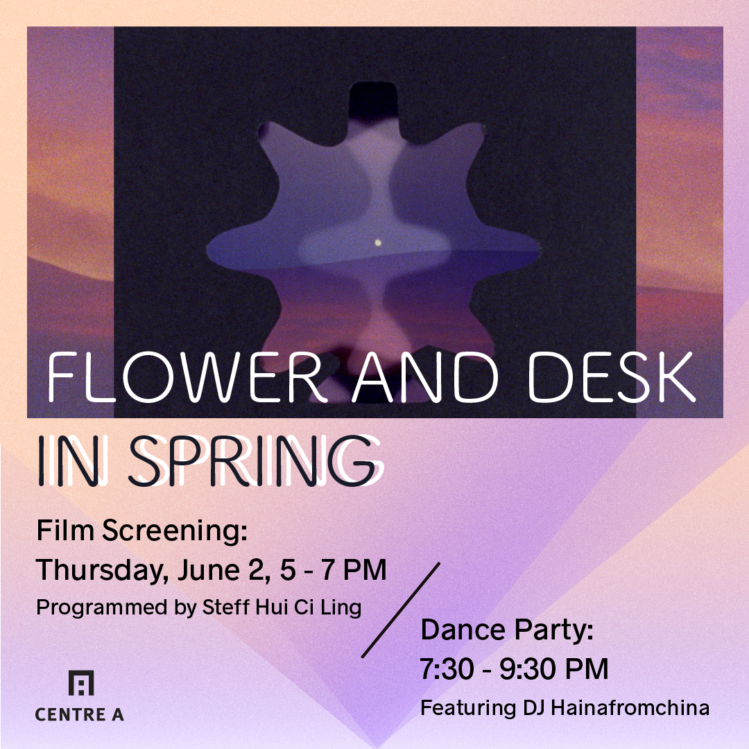
FLOWER AND DESK IN SPRING Film Screening
Thursday, June 2, 2022, 5 – 7 PM PDT
–
Centre A presents the screening of FLOWER AND DESK IN SPRING, a collection of videos with simple and elegant approaches to educational filmmaking and videography featuring a variety of flowers, geometry, and the use of classical, experimental, and anime opening music.
–
Programmed by Steff Hui Ci Ling
“When I started putting the program together, I thought about the times when I worked at a gallery and sat behind a desk while listening to the muffled audio of a video work looping in the black box yonder. I wanted to assemble a program that would be pleasant to listen to if it could be heard from the office throughout the workday, or if the sound happened to bleed through the walls to the neighbouring business inside Keefer Mall. The total screening time is 76-minutes on loop, but since visitors may not be able to view it from the beginning, my other goal for the program was to put together something that would maintain geometric or organic forms on screen throughout, so there would always be an inviting or curious shape or colour (or sound) to greet the visitor.”
Steff Hui Ci Ling is an occasional producer of criticism, pamphlets, stories, essays, exhibitions, reviews, bluntness, anecdotes, shout-outs, wrestling storylines, proposals, applications, jokes, readings, minimal poems, poems, dinner, compliments, and diatribes. She is a student, cultural worker and guest living on the unceded territories of the Musqueam, Squamish, Tsleil-Waututh First Nations. Currently, she is an MA Candidate in the Department of Sociology and Anthropology at Simon Fraser University and working as a teaching assistant in Labour Studies. For fun, she designs and co-edits STILLS: moving image tract and organizes a Marxish Study Group. Her books are NASCAR (Blank Cheque, 2016), CUTS OF THIN MEAT (Spare Room, 2015), and MIXED MARTIAL ARTS (House House Press, forthcoming).
–
Program:
Bruce and Katharine Cornwell, Trio for Three Angles (1968), 8 minutes
Barry Doupé, Thalé (2009), 5 minutes
Bruce and Katharine Cornwell, Journey to the Center of a Triangle (1976), 9 minutes
Lily Jue Sheng and Rita Ferrando, Ikebana (2022), 13 minutes
Bruce and Katharine Cornwell, Congruent Triangles (1976), 7 minutes
EnergizedClippy, Attack on Angles Anime The Final Season OP – My Congruent Angle War (2020), 2 minutes
Barry Doupé and Yota Kobayashi, Shikisou (with visuals) (2012), 12 minutes
EnergizedClippy, Congruent Angles Anime OP – A Cruel Angle’s Thesis (2016), 2 minutes
Bruce and Katharine Cornwell, Similar Triangles (1975), 8 minutes
Bruce and Katharine Cornwell, Dragon Fold (1978), 8 minutes
EnergizedClippy, No Math No Life Anime OP – This Angle (2022), 2 minutes
Bruce and Katharine Cornwell, Trio for Three Angles (1968), 8 minutes
Bruce Cornwell became interested in math films after he saw Disney’s Donald in Mathmagic Land (1959) and thought he could make a better film. Most of Bruce and Katharine Cornwell’s work is now out of distribution, however, much of it is now accessible online to watch and download through YouTube, the Internet Archive and their son Eric’s Vimeo channel, who released some of his parents work under Creative Commons in 2014. The Cornwells made three sequels to Trio, which was the last hand-animated film before switching over to making most of their films on a Tektronix 4051 Graphic Computing System. The subsequent computer-generated triangle trilogy, Congruent Triangles, Similar Triangles and Journey to the Center of a Triangle, is included in this program too.
Barry Doupé, Thalé (2009), 5 minutes
Doupé’s computer animation Thalé is named after the thale cress, arabidopsis thaliana, mouse-ear cress, or arabidopsis, which is a small flowering plant native to Eurasia and Africa. The title flora is a popular model organism in plant biology to understand the molecular biology of plant traits including flower development and light sensing. That is one pedagogical flower! The rotating fictional flowers in the animation incorporate geometric forms inspired by sex toys and Doupé’s most excellent imagination.
Bruce and Katharine Cornwell, Journey to the Center of a Triangle (1976), 9 minutes
Journey to the Center of a Triangle was made on the Tektronix 4051 which only produced black and green vector images, so a creative and elaborate process of layering multiple exposures and optical printing took place during the programming to achieve a variety of coloured dots necessary to be visually distinct and beautifully instructive in the final scene, “The Grand Tour.” Much of that vibrance was lost in the translation from 16mm to VHS scanning, and now viewed on a modern computer screen, it has an even more limited colour gamut. Their son Eric Cornwell asks us to “Please imagine it all in bright, brilliant colours.”
Lily Jue Sheng and Rita Ferrando, Ikebana (2022), 13 minutes
The process of putting the program together actually began with Lily Jue Sheng and Rita Ferrando’s Ikebana. In this film, there are lines read from one of four source texts, instructional or informative books about ikebana (the Japanese art of flower arranging), ”Ikebana presents three main branches,” oh, like a triangle, I thought, “the past, the present and the future.”
Ikebana shares a similar occupation with the films in the Cornwell’s Trio for Triangles while offering its own combination of animation, music, with documentary verité of an ikebana showcase to bring a lightness and action to the educational material.
Bruce and Katharine Cornwell, Congruent Triangles (1976), 7 minutes
Congruent Triangles makes a number of cameos in the program, but a complete viewing brings together the full triangle lesson, while performing an echoing and evolving form expressed in Yota Kobayashi and Barry Doupé’s concept of Shikisou. To a score described as “Bach meets Third Stream Jazz musical score” the congruent triangles ripple out like a Busby Berkley ensemble to produce a hemp-like pattern on the screen in the film’s final act.
EnergizedClippy, Attack on Angles Anime The Final Season OP – My Congruent Angle War (2020), 2 minutes
While I was researching the different versions of Journey posted online, I came across EnergizedClippy’s video in the related videos’ column on YouTube. Attack on Angles Anime The Final Season OP – My Congruent Angle War is a parody of the opening theme song for the final season of Attack on Titan (2013–present). The creator combined footage from Cornwells’ Journey to the Center of a Triangle and Congruent Triangles with the opening song for the very popular anime, My War. As described under the video’s page, “Math tutorials are still the best anime, and is even more hype with the final season!”
The titles of EnergizedClippy’s math tutorial x anime OP (the acronym used to refer to opening credit or opening music) videos combine the titles of Cornwell’s triangle films and the paired song. There are three in total dating from 2016 to 2022, which are all included in this program, as well. These videos reminded me of the interesting ways that people procrastinate when they are studying difficult subjects. These songs lend a melodrama to the otherwise serene triangle films, like a humorous missive from a night of cramming before a big math test.
The program’s title, FLOWER AND DESK IN SPRING, follows in EnergizedClippy’s rhetorical fun and is a hybrid between some of the subject matter of the program — flowers, the seasons, studying math (most likely at a desk) — and the poetic name of a popular Yunnan-style restaurant in the West End, Flower and Horse in Spring, where Henry and I ate once. I think it was over this meal when he asked me to submit an idea for The Living Room.
Barry Doupé and Yota Kobayashi, Shikisou (with visuals) (2012), 12 minutes
The Japanese word “shikisou” means a cyclical gradation of colors (“hue”) as well as “appearance” or “visible figure”. In addition to these definitions metamorphosis is a key concept within Shikisou. There are an infinite number of rhythms in the universe. Some are familiar and comprehensible, others, incognito. Each rhythm echoes from the ones before it, “in a continuous evolution of polyrhythmic and cyclical patterns that are the temporal foundation of the universal symphony.” Shikisou refers to a cycle of seasons to measure time, but expresses the symbolism and emotional assignment that seasons often extend by portraying approaching figurative “sound events” associated with memories of each season. Even though it adheres to a profound principle, something determinative and grandiose like a genesis of rhythm and its resultant patterns, and there is tension between cyclical and non-cyclical layers of sound, the pulsing orb seems to contain and express something less threatening than disorder and more poetic than a scientific axiom.
Shikisou brings to mind the colourful dots in the final scene in Trios, the ones that indicate, but also decorate, the lessons of the triangle. As well, the way the shapes in the Cornwells’ films seem to move and morph as if they tirelessly rehearsed the choreography before committing these movements to the animation process in a similar way to the pulsing orb protagonist of Shikisou. Shikisou also makes use of a form to represent time (the metric of the four seasons), which reminded me of the three main branches of an ikebana arrangement representing the past, present and future.
EnergizedClippy, Congruent Angles Anime OP – A Cruel Angle’s Thesis (2016), 2 minutes
After I discovered Attack on Angles, I wondered if this was some sort of internet trend, however EnergizedClippy seems to be the progenitor and sole producer of the hybrid anime OP x educational films, of which there are three. The first video was 2016’s Congruent Angles Anime OP – A Cruel Angles Thesis. It uses a combination of footage from Journey and Congruent Angles with A Cruel Angel’s Thesis (1995) from Neon Genesis Evangelion. There are lots of joyful and thankful remarks in the comments but the one pinned at the top is pretty good: “Get in the math class, Shinji.” Meanwhile, in the YouTube comments for the Cornwells’ Congruent Triangles, a user states that this is their favourite episode of Evangelion.
Bruce and Katharine Cornwell, Similar Triangles (1975), 8 minutes
Similar Triangles is the first in the Cornwells’ triangle trilogy. In this lesson, we are taught about triangles sharing corresponding angles and proportional sides.To a soothing folk guitar number, this lesson provides an entrancing demonstration of contracting and expanding concentric patterning and pyramidic configurations
Bruce and Katharine Cornwell, Dragon Fold (1978), 8 minutes
The extended title of this film, Dragon Fold and Other Ways to Fill Space is an upbeat visual cabaret of demonstrations in how infinite line segments, infinite closed curves, or a single closed curve multiply to gradually create denser and denser space filling patterns on the screen. Featuring the Sierpinski curve and the eponymous dragon curve.
EnergizedClippy, No Math No Life Anime OP – This Angle (2022), 2 minutes
The popularity of 2016’s Congruent Angles had a second surge of popularity in 2022. As a token of gratitude to their viewers for the 1-million views, the now relatively inactive account posted No Math No Life Anime OP – This Angle. As with the earlier videos, No Math No Life uses footage from the Cornwells’ Journey, Congruent Triangles, in addition to Dragon Fold, and introduces some contemporary source material including videos on linear algebra and fourier series by commensurately serene 3Blue1Brown, a sincerely helpful math edutainment YouTuber. The background music, This Game, was the opening credits for the 2014 anime, No Game, No Life, which was not renewed for a second season because of a controversy about plagiarism. This is EnergizedClippy’s first edit made entirely with Adobe Premiere CC 2018, instead of Vegas Pro.
IMPORTANT NOTES REGARDING YOUR VISIT:
- Face masks or face coverings are encouraged when not drinking or eating. We also encourage you to sanitize your hands before and after visiting. Masks and hand sanitizer are available for you as needed.
- Due to Sun Wah Centre’s security measures, please locate the security guard posted at the front gate to be let into the building. Otherwise, please call Centre A at (604) 683-8326 during the event hours.
Accessibility: The gallery is wheelchair and walker accessible. If you have specific accessibility needs, please contact us at (604) 683-8326 or [email protected].
Centre A is situated on the unceded territories of the Musqueam, Squamish, and Tsleil-Waututh peoples. We honour, respect, and give thanks to our hosts.
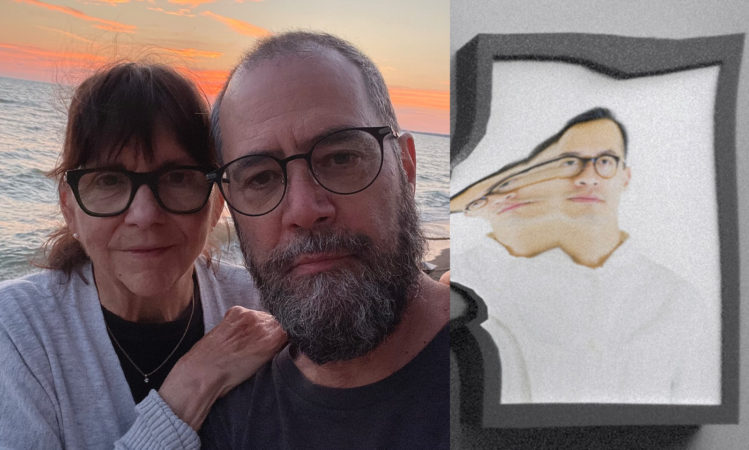
Saturday, May 21, 2022, 2 – 3 PM PDT / 5 – 6 PM EDT
Join us online via Zoom for a panel discussion with Lisa Steele, Kim Tomczak, and Alvin Luong on May 21, at 2 PM PDT / 5 PM EDT.
Register HERE.
The panel discussion will focus on Steele and Tomczak’s video The Afternoon Knows what the Morning Never Suspected (2017), a reflection on war, national power, and migration. The panel discussion will be followed by a short Q & A.
The video is currently on view at Centre A, as part of the current exhibition The Living Room, until May 28, 2022.
The film will be available for viewing online until May 21 here.
_
Lisa Steele and Kim Tomczak have collaborated since 1983, producing videotapes, performances, and photo/text works that have been exhibited in festivals, museums, and galleries around the world. Their numerous grants and awards include the Bell Canada prize for excellence in Video Art, a Toronto Arts Award for Media Arts and in 2005, a Governor General’s Award for lifetime achievement in Visual & Media Arts. They are co-founders of Vtape, a Toronto media arts resource centre and are Professors Emeriti at the University of Toronto in the John H. Daniels Faculty of Architecture, Landscape, and Design.
Alvin Luong works with stories of human migration, land, and dialogues from diasporic working class communities to create artworks that reflect upon historical development and its intimate effects on the lives of people. Luong has shown and screened artworks at the Images Festival (Toronto), Boers-Li Gallery (Beijing), Gudskul (Jakarta), and The Polygon Gallery (Vancouver). The artist has held research and resident artist appointments at the Inside-Out Art Museum (Beijing), HB Station Contemporary Art Research Center (Guangzhou), the Art Gallery of Ontario (Toronto), and Gallery TPW (Toronto).
Accessibility: The gallery is wheelchair and walker accessible. If you have specific accessibility needs, please contact us at (604) 683-8326 or [email protected].
Centre A is situated on the unceded territories of the Musqueam, Squamish, and Tsleil-Waututh peoples. We honour, respect, and give thanks to our hosts.
 May 15, 2022, 2 – 3:30 PM PDT
May 15, 2022, 2 – 3:30 PM PDT
Centre A is pleased to be a partner of the LiterAsian Festival 2022 and host the Asian Literature Circle on May 15.
Purchase festival passes and view the festival schedule HERE.
–
The Asian Literature Circle has met for over 20 years and for all self-proclaimed literati. Come join LiterAsian for an informal discussion on books on or about Asia that the festival have enjoyed.
This year, five books were chosen:
- Forbidden Purple City by Philip Huynh
- How to Pronounce Knife by Souvankham Thammavongsa
- Patron Saint of Nothing by Randy Ribay
- Made in Korea by Sarah Suk
- Diary of Dukesang Wong by Wanda Joy Hoe
LiterAsian welcome audience participation, so if you have read any of these titles, join the discussion!
LiterAsian will give a brief history of the Circle to cover their many years of readings and can provide ideas on how to start your own circle.
–
IMPORTANT NOTES REGARDING YOUR VISIT:
1. Be gently reminded that you will need to be fully vaccinated to attend this event. Face masks or face coverings are encouraged when not drinking or eating. We also encourage you to sanitize your hands before and after visiting. Masks and hand sanitizer are available for you as needed.
2. Due to Sun Wah Centre’s security measures, please locate the security guard posted at the front gate to be let into the building. Otherwise, please call Centre A at (604) 683-8326 during the event hours.
Accessibility: The gallery is wheelchair and walker accessible. If you have specific accessibility needs, please contact us at (604) 683-8326 or [email protected].
Centre A is situated on the unceded territories of the Musqueam, Squamish, and Tsleil-Waututh peoples. We honour, respect, and give thanks to our hosts.
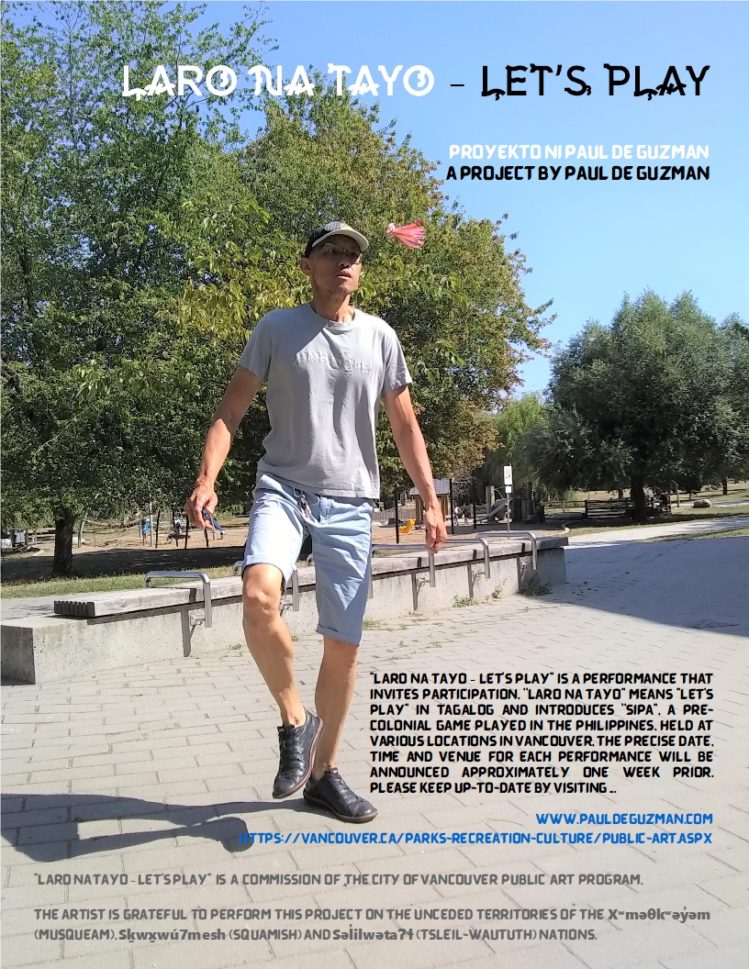
Saturday, May 28, 2022, 2:30 – 4:30 PM PDT
Centre A is pleased to host Paul de Guzman’s performance of laro na tayo – let’s play for the City of Vancouver Public Art Program.
Register HERE.
Meet at Unit 205, 268 Keefer Street, Vancouver, BC, V6A 1X5
–
“laro na tayo – let’s play” (“laro” for short) is part performance, social practice and residual installation. “laro na tayo” means “let’s play” in Tagalog. The project channels the nomadic and temporary as a post-colonial strategy referencing the Filipino Canadian experience. “laro” confronts the complexities of migration, colonization, settlement and multiculturalism through the didactics of a childhood game and the history it represents.
“laro” begins and ends with the cherished childhood memory of play. Once the national sport of the Philippines, the game of “sipa” (meaning “kick”) is ubiquitous in the playgrounds of elementary schools. Its origin predates the Spanish colonization of the 16th century and is played with a shuttlecock-like object made from a “tingga” (metal washer) wrapped in straw/cloth.
The act of kicking and propelling the “sipa” is a willfully transient act referencing the nomadic and migratory. Further reflection reveals that these early age experiences resonate with adult concerns of fair play, perservance, migration, and other grown up realities. “laro” bridges the temporal gap between childhood and adult experiences offering a democracy of expression. It symbolizes a desire from our experiences and memories to be recognized, resulting in a cohesive and meaningful dialogue”
“laro na tayo – let’s play” is commissioned by the City of Vancouver Public Art Program. The artist is grateful to perform this project on the unceded territories of the Musqueam, Squamish, and Tsleil-Waututh Nations.
The performance will be followed by a Q&A session with the artist.
The project will be performed at various outdoor and indoor locations within the city of Vancouver. The venue, date and time of each event will be announced on the artist’s website prior to the performance.
–
Paul de Guzman
Dividing his time between his birthplace of Mandaluyong City, Philippines and Vancouver, Canada, Paul de Guzman’s concept driven artistic practice is governed by nomadic gestures and transient objects. His artistic strategy can be described as having an acute sensitivity toward an idea, a site, its public and its surroundings complimented by his interests in fleeting gestures, social structures, urbanism and post-colonial concerns.
Please visit www.pauldeguzman.com for more information about de Guzman’s work.
–
IMPORTANT NOTES REGARDING YOUR VISIT:
1. Be gently reminded that you will need to be fully vaccinated to attend this event. Face masks or face coverings are encouraged when not drinking or eating. We also encourage you to sanitize your hands before and after visiting. Masks and hand sanitizer are available for you as needed.
2. Due to Sun Wah Centre’s security measures, please locate the security guard posted at the front gate to be let into the building. Otherwise, please call Centre A at (604) 683-8326 during the event hours.
3. Centre A is wheelchair and walker accessible. If you have specific accessibility needs, please contact us at the phone number above, or via email at [email protected].
Accessibility: The gallery is wheelchair and walker accessible. If you have specific accessibility needs, please contact us at (604) 683-8326 or [email protected].
Centre A is situated on the unceded territories of the Musqueam, Squamish, and Tsleil-Waututh peoples. We honour, respect, and give thanks to our hosts.
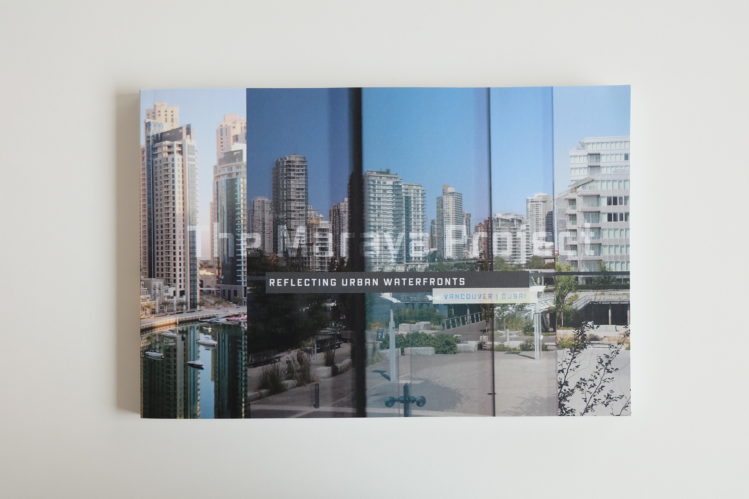
Friday, May 6, 2022, 5 – 7 PM PDT
Join us at Centre A for the official book launch of “The Maraya Project: Reflecting Urban Waterfronts: Vancouver | Dubai” by M. Simon Levin, Glen Lowry, and Henry Tsang.
Register HERE.
—
The Maraya Project documents the collaboration of artists M. Simon Levin, Henry Tsang, and writer Glen Lowry as they track the re-appearance of Vancouver’s downtown waterfront in the Arabian desert twelve time zones away. Maraya, which means mirror or reflection in Arabic, focuses on the urban regeneration megaproject in Vancouver’s False Creek that became an impetus for new thinking about 21st-century urban development and how it subsequently shaped one of Dubai’s first master-planned developments, the Dubai Marina.
The publication includes dozens of full-colour photographs, including foldouts, accompanied by poetic texts, descriptions, lists of projects, events, and activities and a foreword by the Maraya team. Central to the book is a long-form essay by Dr. Alice Ming Wai Jim that traces the eight-year interdisciplinary collaboration and posits the Maraya Project as a kind of imaginative worlding research-creation practice that potentially embodies postcolonial urbanism as a critical transnational methodology. Accompanying writings by Robert Ferry and Elizabeth Monoian, and Kevin Hamilton, respectively, provide insight into the experience of living and working in Dubai at a time of sensational and sensationalized growth, as well as reflecting on the experience of pulling the Sisyphean Cart along the waterfronts while considering the relationship between new media artistic practice and colonial spaces.
An early iteration of Maraya curated by Makiko Hara was exhibited at Centre A in 2011. The 2011 project included an exhibition, a series of public talks, walking tours, and a commissioned interactive website. For the first time in Centre A’s history, the gallery was able to commission the artists to develop an experimental internet platform.
The book is published by Gail and Stephen A. Jarislowsky Institute for Studies in Canadian Art.
The book will be available for purchase for a special discounted price of $25 at the launch (regular $30).
—
Glen Lowry is a researcher, writer, editor, and publisher whose work investigates new forms of critical and creative practice, most often from the perspective of collaborative investigation. Trained as a cultural theorist (PhD English), Lowry works with artists and collectives on projects that look at questions of social justice and emergent publics. He edited the SFU-based cultural journal West Coast LINE (2000-2012), cofounded LINEbooks | Burnaby, and as editor / consultant with the Aboriginal Healing Foundation (2011-2015), travelled across Canada participating in discussions about Truth and Reconciliation. He is currently Executive Director and Advisor to the Provost, Partnerships, Outreach & Research at Ontario College of Art & Design University.
M. Simon Levin has co-created site-based systems that explore the aesthetics of engagement using a variety of designed forms and tools that address our many publics. From large-scale projects in urban environments such as a photo agency for inner city youth, indigenous, medicinal and food-security gardens downtown to a variety of psycho-geographic and psycho-sonic mappings of space, Simon works with diverse communities and audiences towards realising these spatial and pedagogical projects. He has taught in Graduate Studies, Critical and Cultural Studies and Dynamic Media at Emily Carr University of Art and Design and the Department of Art History and Visual Art at UBC. He has published curriculum on Contemporary Public Art, and co-contributed a chapter to Routledge’s Cultural Mapping as Cultural Inquiry. He is currently co-director of Coppermoss Retreat and Residency (est. 2016), situated on the traditional lands of the shíshalh nation in the village of Tuwanek, BC. Seeking to trouble his settler relationship to the land; Coppermoss invites artists up to live and work at the edge of wilderness, fostering new approaches to decolonizing through land-based pedagogy and bio-remediation projects.
Henry Tsang’s projects explore the spatial politics of history, language, community, food and cultural translation in relationship to place. They take the form of gallery exhibitions, pop-up street food offerings, 360 video walking tours, curated dinners, ephemeral and permanent public art, employing video, photography, language, interactive media, food and convivial events. Projects include: Tansy Point, a video installation of the site of the 1851 treaty signings by the Chinook peoples and the US government that were never ratified; 360 Riot Walk, a 360 video walking tour of the 1907 Anti-Asian Riots in Vancouver, Canada; RIOT FOOD HERE, a public offering of food reflecting on the 1907 Riots; video installations Orange County, and Olympus, shot in California, Beijing, Torino and Vancouver, that explore overlapping urban and socio-political spaces; and Welcome to the Land of Light, a public artwork along Vancouver’s seawall that underscores the 19th Century trade language Chinook Jargon and the English that replaced it. He is based on the unceded territories of the Musqueam, Squamish, Sto:lo, and Tsleil- Waututh Peoples.
—
Centre A is wheelchair and walker accessible. Please contact [email protected] with any questions if you require any assistance.
Centre A is situated on the unceded territories of the Musqueam, Squamish, and Tsleil-Waututh peoples. We honour, respect, and give thanks to our hosts.
Notes Regarding the Event:
- Be gently reminded that you will need to be fully vaccinated to attend this event. Face masks or face coverings are encouraged when not drinking or eating. We also encourage you to sanitize your hands before and after visiting. Masks and hand sanitizer are available for you as needed.
- Face masks or face coverings are necessary when you are in the gallery space. We also encourage you to sanitize your hands before and after visiting. Masks and hand sanitizer are available for you as needed.
- Due to Sun Wah Centre’s security measures, please locate the security guard posted at the front gate to be let into the building. Otherwise, please call Centre A at (604) 683-8326 during the event hours.
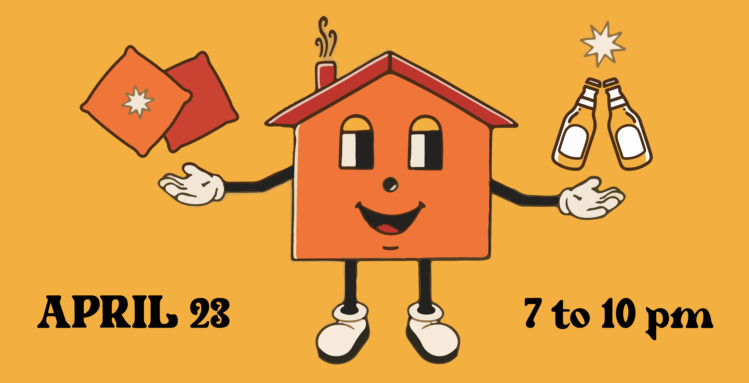
The Centre A Living Room Presents…
Cushions N’ Coolers: A Members Mixer + Dance Party
Saturday, April 23, 2022
7 – 10 PM PDT
Register HERE.
—
Join us at our upcoming members mixer in The Living Room! There will be drinks, sangria, snacks, company, and a special headliner – artist and musician Nancy Lee, who will open their DJ set at 8 pm. Dress code: As casual as possible.
Our early bird deal for non-members gets you two tickets for $12, so make sure to bring along a guest because we’ve got plenty of cushions to go around! This exclusive sale will be on from now until April 9, 2022.
Come on out. Let’s dance!
For any accessibility needs, please email [email protected].
-
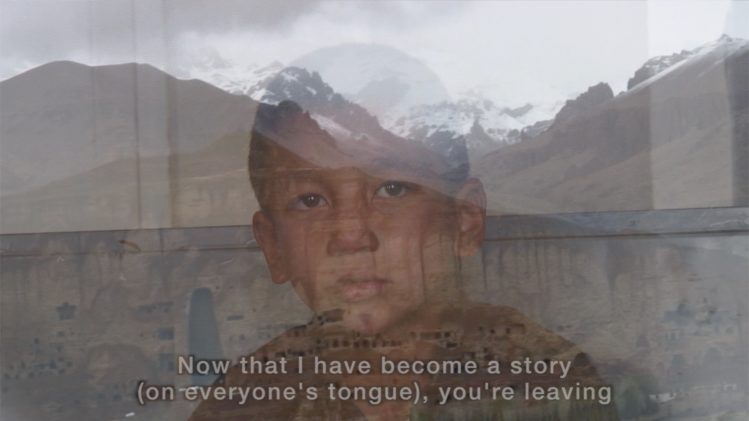
Image from untitled part 9: this time (2020) by Jayce Salloum. Courtesy of the artist. -
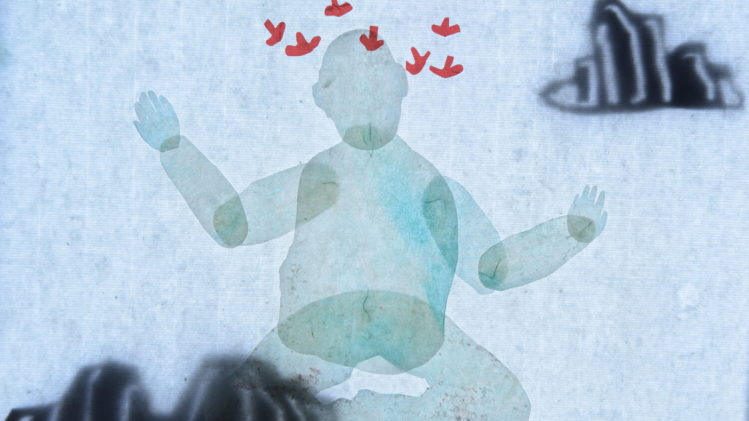
Image from This Does Not Authorize Re-Entry (2021) by Jenny Yujia Shi. Courtesy of the artist. -
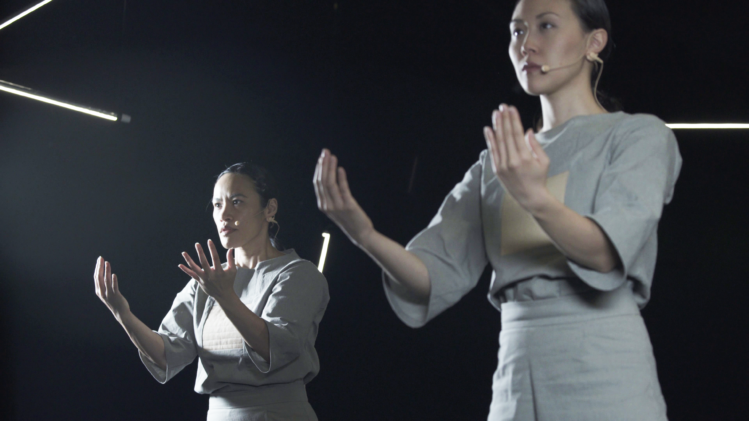
Image from K BODY AND MIND (2021) by A Wake of Vultures | Conor Wylie. Courtesy of the artists.
Entry/Exit: A Film Screening
Saturday, April 23, 2022, 4 – 6:30 PM PDT
—
Centre A’s Living Room presents Entry/Exit: A Film Screening, a program of films that consider the themes of movement and dislocation. The featured artists and collective take into consideration the two themes through lived experiences of immigration, war, and disruption through the lens of animation, documentary, and interdisciplinary performance. The films, therefore, create an intermediate space that points to a push-and-pull sensibility or visual language.
Program:
Jayce Salloum, untitled part 9: this time (2020), 6:13 minutes. North American Premiere.
Jenny Yujia Shi, This Does Not Authorize Re-Entry (2021), 4:22 minutes
A Wake of Vultures | Conor Wylie, K BODY AND MIND (2021), 75 minutes









